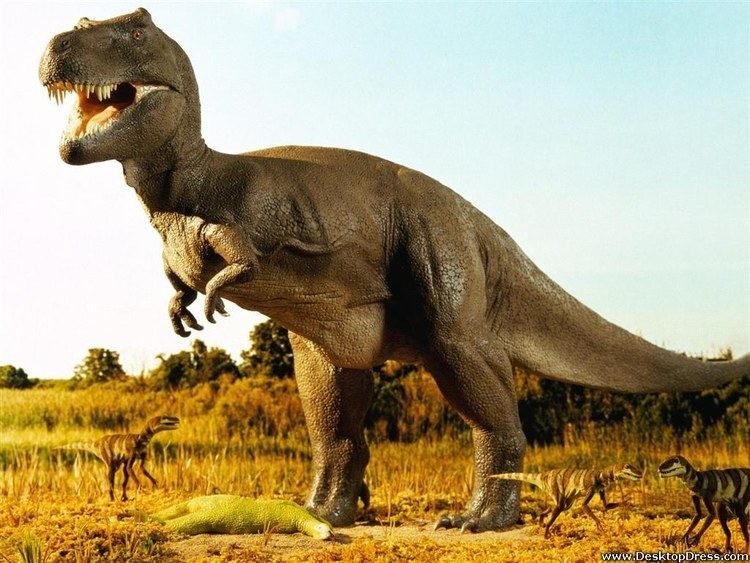 | ||
Human prehistory 101 prologue
Prehistory means literally "before history", from the Latin word for "before," præ, and Greek ιστορία. Human prehistory is the period from the time that behaviorally and anatomically modern humans first appear until the appearance of recorded history following the invention of writing systems. Since both the time of settlement of modern humans and the evolution of human civilisations differ from region to region, prehistory starts and ends at different moments in time, depending on the region concerned.
Contents
- Human prehistory 101 prologue
- Definition
- History of the term
- Means of research
- Palaeolithic
- Mesolithic
- Neolithic
- Chalcolithic
- Bronze Age
- Iron Age
- Timeline
- By region
- References
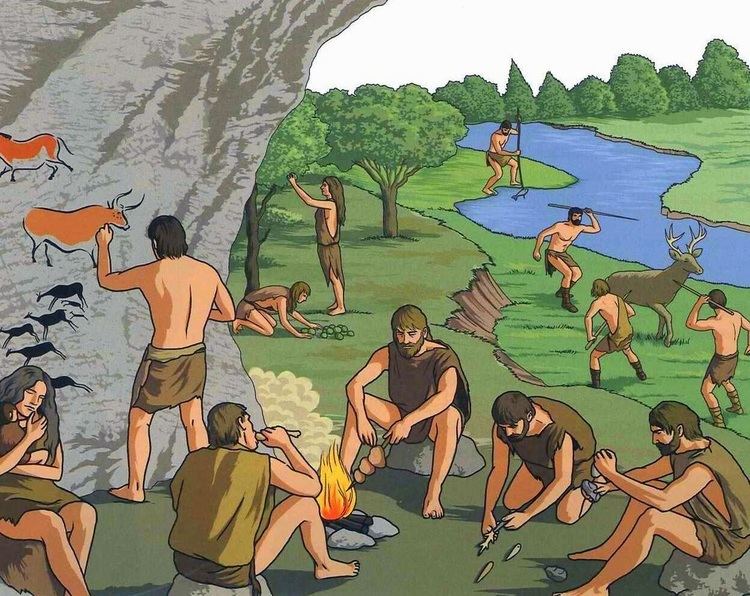
Sumer in Mesopotamia, the Indus valley civilisation and ancient Egypt were the first civilisations to develop their own scripts, and to keep historical records; this took place already during the Early Bronze Age. Neighbouring civilisations were the first to follow. Most other civilisations reached the end of prehistory during the Iron Age.
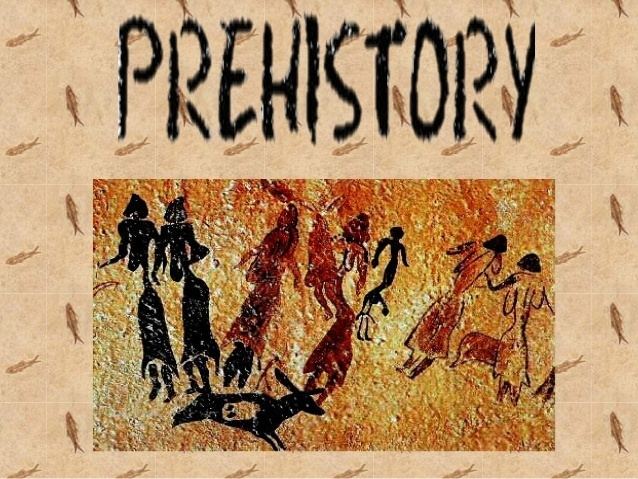
The beginning of written materials (and so the beginning of local "historic times") varies; in many cultures, especially outside Eurasia, it follows conquest by a culture with writing, and often the earliest written sources on pre-literate cultures come from their literate neighbours. The period when a culture is written about by others, but has not developed its own writing is often known as the protohistory of the culture.
By definition, there are no written records from human prehistory, so dating of prehistoric materials is crucial. Clear techniques for dating were not well-developed until the 19th century.
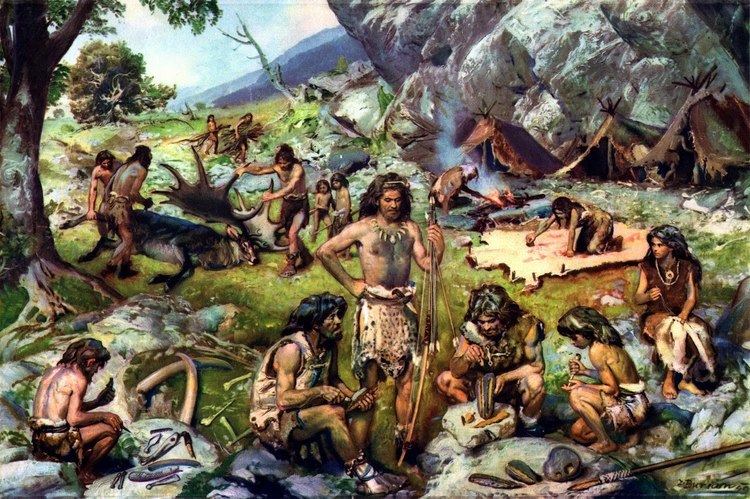
This article is concerned with human prehistory as defined here above. There are separate articles for the overall history of the Earth and the history of life before humans. However, for the human race as a whole, prehistory ends when Recorded history begins with the accounts of the ancient world around the 4th millennium BC, and coincides with the invention of writing.
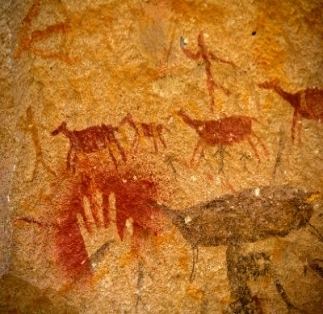
Definition
Beginning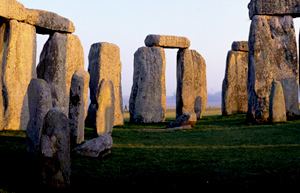
The term "prehistory" can refer to the vast span of time since the beginning of the Universe or the Earth, but more often it refers to the period since life appeared on Earth, or even more specifically to the time since human-like beings appeared.
EndThe date marking the end of prehistory in a particular culture or region, that is, the date when relevant written historical records become a useful academic resource, varies enormously from region to region. For example, in Egypt it is generally accepted that prehistory ended around 3200 BC, whereas in New Guinea the end of the prehistoric era is set much more recently, at around 1900 AD. In Europe the relatively well-documented classical cultures of Ancient Greece and Ancient Rome had neighbouring cultures, including the Celts and to a lesser extent the Etruscans, with little or no writing, and historians must decide how much weight to give to the often highly prejudiced accounts of these "prehistoric" cultures in Greek and Roman literature.
Time periodsIn dividing up human prehistory, historians typically use the three-age system, whereas scholars of pre-human time periods typically use the well-defined geologic record and its internationally defined stratum base within the geologic time scale. The three-age system is the periodization of human prehistory into three consecutive time periods, named for their respective predominant tool-making technologies:
History of the term
The notion of "prehistory" began to surface during the Enlightenment in the work of antiquarians who used the word 'primitive' to describe societies that existed before written records. The first use of the word prehistory in English, however, occurred in the Foreign Quarterly Review in 1836.
The use of the geologic time scale for pre-human time periods, and of the three-age system for human prehistory, is a system that emerged during the late nineteenth century in the work of British, German and Scandinavian archeologists, antiquarians and anthropologists.
Means of research
The main source for prehistory is archaeology, but some scholars are beginning to make more use of evidence from the natural and social sciences. This view has been articulated by advocates of deep history.
The primary researchers into human prehistory are archaeologists and physical anthropologists who use excavation, geologic and geographic surveys, and other scientific analysis to reveal and interpret the nature and behavior of pre-literate and non-literate peoples. Human population geneticists and historical linguists are also providing valuable insight for these questions. Cultural anthropologists help provide context for societal interactions, by which objects of human origin pass among people, allowing an analysis of any article that arises in a human prehistoric context. Therefore, data about prehistory is provided by a wide variety of natural and social sciences, such as paleontology, biology, archaeology, palynology, geology, archaeoastronomy, comparative linguistics, anthropology, molecular genetics and many others.
Human prehistory differs from history not only in terms of its chronology but in the way it deals with the activities of archaeological cultures rather than named nations or individuals. Restricted to material processes, remains and artifacts rather than written records, prehistory is anonymous. Because of this, reference terms that prehistorians use, such as Neanderthal or Iron Age are modern labels with definitions sometimes subject to debate.
Palaeolithic
"Palaeolithic" means "Old Stone Age," and begins with the first use of stone tools. The Paleolithic is the earliest period of the Stone Age.
The early part of the Palaeolithic is called the Lower Palaeolithic, which predates Homo sapiens, beginning with Homo habilis (and related species) and with the earliest stone tools, dated to around 2.5 million years ago. Evidence of Control of fire by early humans during the Lower Palaeolithic Era is uncertain and has at best limited scholarly support. The most widely accepted claim is that H. erectus or H. ergaster made fires between 790,000 and 690,000 BP (before the present period) in a site at Bnot Ya'akov Bridge, Israel. The use of fire enabled early humans to cook food, provide warmth, and have a light source at night.
Early Homo sapiens originated some 200,000 years ago, ushering in the Middle Palaeolithic. Anatomic changes indicating modern language capacity also arise during the Middle Palaeolithic. During the Middle Palaeolithic Era, there is the first definitive evidence of human use of fire. Sites in Zambia have charred bone and wood that have been dated to 61,000 B.P. The systematic burial of the dead, music, early art, and the use of increasingly sophisticated multi-part tools are highlights of the Middle Paleolithic.
Throughout the Palaeolithic, humans generally lived as nomadic hunter-gatherers. Hunter-gatherer societies tended to be very small and egalitarian, though hunter-gatherer societies with abundant resources or advanced food-storage techniques sometimes developed sedentary lifestyles with complex social structures such as chiefdoms, and social stratification. Long-distance contacts may have been established, as in the case of Indigenous Australian "highways" known as songlines.
Mesolithic
The "Mesolithic," or "Middle Stone Age" (from the Greek "mesos," "middle," and "lithos," "stone") was a period in the development of human technology between the Palaeolithic and Neolithic periods of the Stone Age.
The Mesolithic period began at the end of the Pleistocene epoch, some 10,000 BP, and ended with the introduction of agriculture, the date of which varied by geographic region. In some areas, such as the Near East, agriculture was already underway by the end of the Pleistocene, and there the Mesolithic is short and poorly defined. In areas with limited glacial impact, the term "Epipalaeolithic" is sometimes preferred.
Regions that experienced greater environmental effects as the last ice age ended have a much more evident Mesolithic era, lasting millennia. In Northern Europe, societies were able to live well on rich food supplies from the marshlands fostered by the warmer climate. Such conditions produced distinctive human behaviours that are preserved in the material record, such as the Maglemosian and Azilian cultures. These conditions also delayed the coming of the Neolithic until as late as 4000 BC (6,000 BP) in northern Europe.
Remains from this period are few and far between, often limited to middens. In forested areas, the first signs of deforestation have been found, although this would only begin in earnest during the Neolithic, when more space was needed for agriculture.
The Mesolithic is characterized in most areas by small composite flint tools — microliths and microburins. Fishing tackle, stone adzes and wooden objects, e.g. canoes and bows, have been found at some sites. These technologies first occur in Africa, associated with the Azilian cultures, before spreading to Europe through the Ibero-Maurusian culture of Northern Africa and the Kebaran culture of the Levant. Independent discovery is not always ruled out.
Neolithic
"Neolithic" means "New Stone Age." Although there were several species of human beings during the Paleolithic, by the Neolithic only Homo sapiens sapiens remained. (Homo floresiensis may have survived right up to the very dawn of the Neolithic, about 12,200 years ago.) This was a period of primitive technological and social development. It began about 10,200 BC in some parts of the Middle East, and later in other parts of the world and ended between 4,500 and 2,000 BC. The Neolithic is a progression of behavioral and cultural characteristics and changes, including the use of wild and domestic crops and of domesticated animals.
Early Neolithic farming was limited to a narrow range of plants, both wild and domesticated, which included einkorn wheat, millet and spelt, and the keeping of dogs, sheep and goats. By about 6,900–6,400 BC, it included domesticated cattle and pigs, the establishment of permanently or seasonally inhabited settlements, and the use of pottery. The Neolithic period saw the development of early villages, agriculture, animal domestication, tools and the onset of the earliest recorded incidents of warfare. The Neolithic era commenced with the beginning of farming, which produced the "Neolithic Revolution". It ended when metal tools became widespread (in the Copper Age or Bronze Age; or, in some geographical regions, in the Iron Age).The term Neolithic is commonly used in the Old World, as its application to cultures in the Americas and Oceania that did not fully develop metal-working technology raises problems.
Settlements became more permanent with some having circular houses with single rooms made of mudbrick. Settlements might have a surrounding stone wall to keep domesticated animals in and protect the inhabitants from other tribes. Later settlements have rectangular mud-brick houses where the family lived together in single or multiple rooms. Burial findings suggest an ancestor cult where people preserved skulls of the dead. The Vinča culture may have created the earliest system of writing. The megalithic temple complexes of Ġgantija are notable for their gigantic structures. Although some late Eurasian Neolithic societies formed complex stratified chiefdoms or even states, states evolved in Eurasia only with the rise of metallurgy, and most Neolithic societies on the whole were relatively simple and egalitarian. Most clothing appears to have been made of animal skins, as indicated by finds of large numbers of bone and antler pins which are ideal for fastening leather. Wool cloth and linen might have become available during the later Neolithic, as suggested by finds of perforated stones which (depending on size) may have served as spindle whorls or loom weights.
Chalcolithic
In Old World archaeology, the "Chalcolithic", "Eneolithic" or "copper Age" refers to a transitional period where early copper metallurgy appeared alongside the widespread use of stone tools. During this period, some weapons and tools were made of copper. This period was still largely Neolithic in character. It is a phase of the Bronze Age before it was discovered that adding tin to copper formed the harder bronze. The Copper Age was originally defined as a transition between the Neolithic and the Bronze Age. However, because it is characterized by the use of metals, the Copper Age is considered a part of the Bronze Age rather than the Stone Age.
An archaeological site in Serbia contains the oldest securely dated evidence of copper making at high temperature, from 7,500 years ago. The find in June 2010 extends the known record of copper smelting by about 800 years, and suggests that copper smelting may have been invented in separate parts of Asia and Europe at that time rather than spreading from a single source. The emergence of metallurgy may have occurred first in the Fertile Crescent, where it gave rise to the Bronze Age in the 4th millennium BC (the traditional view), though finds from the Vinča culture in Europe have now been securely dated to slightly earlier than those of the Fertile Crescent. Timna Valley contains evidence of copper mining 9,000 to 7,000 years ago. The process of transition from Neolithic to Chalcolithic in the Middle East is characterized in archaeological stone tool assemblages by a decline in high quality raw material procurement and use. North Africa and the Nile Valley imported its iron technology from the Near East and followed the Near Eastern course of Bronze Age and Iron Age development. However the Iron Age and Bronze Age occurred simultaneously in much of Africa.
Bronze Age
The Bronze Age is the earliest period in which some civilisations have reached the end of prehistory, by introducing written records. The Bronze Age or parts thereof are thus considered to be part of prehistory only for the regions and civilisations who adopted or developed a system of keeping written records during later periods. The invention of writing coincides in some areas with the early beginnings of the Bronze Age. Soon after the appearance of writing, people started creating texts including written accounts of events and records of administrative matters.
The term Bronze Age refers to a period in human cultural development when the most advanced metalworking (at least in systematic and widespread use) included techniques for smelting copper and tin from naturally occurring outcroppings of ores, and then combining them to cast bronze. These naturally occurring ores typically included arsenic as a common impurity. Copper/tin ores are rare, as reflected in the fact that there were no tin bronzes in Western Asia before 3000 BC. The Bronze Age forms part of the three-age system for prehistoric societies. In this system, it follows the Neolithic in some areas of the world.
While copper is a common ore, deposits of tin are rare in the Old World, and often had to be traded or carried considerable distances from the few mines, stimulating the creation of extensive trading routes. In many areas as far apart as China and England, the valuable new material was used for weapons but for a long time apparently not available for agricultural tools. Much of it seems to have been hoarded by social elites, and sometimes deposited in extravagant quantities, from Chinese ritual bronzes and Indian copper hoards to European hoards of unused axe-heads.
By the end of the Bronze Age large states, which are often called empires, had arisen in Egypt, China, Anatolia (the Hittites) and Mesopotamia, all of them literate.
Iron Age
The Iron Age is not part of prehistory for all civilisations who had introduced written records during the Bronze Age. Most remaining civilisations did so during the Iron Age, often through conquest by the empires, which continued to expand during this period. For example, in most of Europe conquest by the Roman Empire means that the term Iron Age is replaced by "Roman", "Gallo-Roman" and similar terms after the conquest.
In archaeology, the Iron Age refers to the advent of ferrous metallurgy. The adoption of iron coincided with other changes in some past cultures, often including more sophisticated agricultural practices, religious beliefs and artistic styles, which makes the archaeological Iron Age coincide with the "Axial Age" in the history of philosophy. Although iron ore is common, the metalworking techniques necessary to use iron are very different from those needed for the metal used earlier, and iron was slow-spreading and for long mainly used for weapons, while bronze remained typical for tools, as well as art.
Timeline
All dates are approximate and conjectural, obtained through research in the fields of anthropology, archaeology, genetics, geology, or linguistics. They are all subject to revision due to new discoveries or improved calculations. BP stands for "Before Present (1950)." BCE stands for Before common era".
